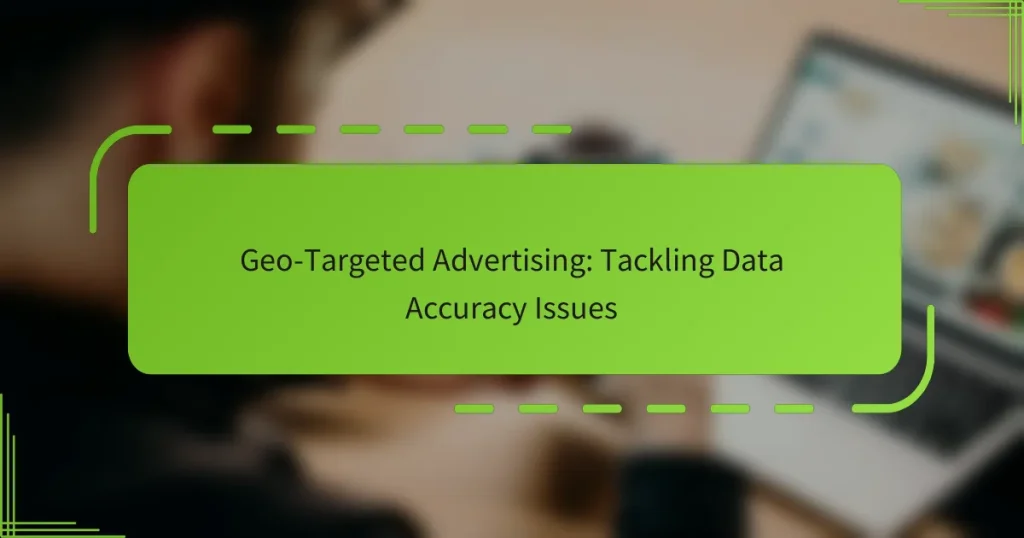Geo-targeted advertising presents unique challenges in Georgia, including limited data availability, regulatory constraints, and the need for culturally relevant messaging. To enhance the effectiveness of these campaigns, businesses can utilize local data, customize their content, and adopt advanced targeting technologies. By doing so, they can better connect with their audience, ultimately boosting engagement and conversion rates.
ჯეო–სივრცული რეკლამირება: მონაცემთა სიზუსტის პრობლემებზე გავლენა
Geo-Targeted Advertising: გეოფენსინგის შეზღუდვები და გადაწყვეტილებები
Geo-Targeted რეკლამირება: კონფიდენციალურობის პრობლემების გადალახვა
Geo-Targeted Ads: addressing ტექნიკური გამოწვევები მობილურ აპებში
Geo-Targeted რეკლამირება: შეწონილი ბაზრებში კონკურენციის მართვა
გეო-ტარგეტირებული რეკლამირება: რეკლამის დაღლილობის რისკების შემცირება
What are the main challenges in geo-targeted ads in Georgia?
The main challenges in geo-targeted ads in Georgia include limited data availability, regulatory restrictions, and cultural differences in messaging. These factors can significantly impact the effectiveness of advertising campaigns aimed at specific geographic areas.
Limited data availability
In Georgia, access to reliable data for geo-targeted advertising can be restricted. Many businesses may struggle to gather sufficient information on local consumer behavior, preferences, and demographics, which is crucial for crafting effective ads.
To overcome this challenge, companies can utilize local market research firms or collaborate with digital platforms that offer geo-targeting services. Investing in analytics tools can also help in gathering insights about the target audience.
Regulatory restrictions
Geo-targeted advertising in Georgia is subject to various regulations that can limit how businesses collect and use consumer data. Compliance with local privacy laws is essential to avoid legal issues and fines.
Advertisers should stay informed about the latest regulations and ensure that their data collection practices align with legal requirements. Consulting with legal experts can provide clarity on permissible advertising strategies.
Cultural differences in messaging
Cultural nuances in Georgia can affect how messages are received by different audiences. Advertisers must be sensitive to local customs, language, and values when creating geo-targeted ads.
To effectively engage with diverse groups, businesses should tailor their messaging to resonate with local cultures. Conducting focus groups or surveys can provide valuable feedback on how well advertisements align with cultural expectations.
How can businesses overcome geo-targeting challenges?
Businesses can overcome geo-targeting challenges by leveraging local data, tailoring content to fit cultural contexts, and utilizing advanced targeting technologies. These strategies help ensure that advertisements resonate with the intended audience, increasing engagement and conversion rates.
Utilizing local data sources
Accessing local data sources is crucial for effective geo-targeting. Businesses should consider using regional databases, customer location analytics, and social media insights to gather relevant information. This data can help identify local preferences, trends, and behaviors that influence purchasing decisions.
For example, a retail store in Tbilisi might analyze local shopping habits to determine the best times for promotions or the types of products that are most popular in that area. Utilizing local data can enhance the relevance of ads and improve overall campaign performance.
Adapting content for cultural relevance
Adapting content to reflect cultural nuances is essential for successful geo-targeted advertising. Businesses should ensure that their messaging aligns with local customs, values, and language. This might involve translating content accurately and considering local idioms or references that resonate with the target audience.
For instance, a company promoting a new beverage in Georgia could highlight traditional ingredients or local flavors that appeal to Georgian consumers. This cultural relevance can significantly enhance the effectiveness of marketing efforts.
Implementing advanced targeting technologies
Advanced targeting technologies, such as geofencing and location-based advertising, can significantly improve the precision of geo-targeted ads. These technologies enable businesses to deliver ads to users based on their real-time location, ensuring that promotions reach potential customers when they are most likely to engage.
For example, a restaurant could use geofencing to send special offers to users who enter a specific radius around its location. This immediate and contextual approach can drive foot traffic and increase sales during peak hours.
What tools can enhance geo-targeted advertising?
Several tools can significantly improve the effectiveness of geo-targeted advertising by allowing marketers to reach specific audiences based on their geographic location. Key platforms like Google Ads and Facebook Ads offer advanced targeting features, while technologies such as geofencing provide innovative ways to engage consumers in real-time.
Google Ads location targeting
Google Ads location targeting enables advertisers to customize their campaigns based on geographic areas, from countries to specific postal codes. This feature allows businesses to tailor their ads to local audiences, increasing relevance and engagement.
When setting up location targeting, consider using radius targeting to reach users within a certain distance from your business. This approach can be particularly effective for local businesses aiming to attract nearby customers.
Facebook Ads geo-targeting features
Facebook Ads offers robust geo-targeting options that allow advertisers to reach users based on their current location, as well as their interests and behaviors. Advertisers can target specific cities, regions, or even neighborhoods, making it easier to connect with local audiences.
Utilizing Facebook’s geo-targeting features can enhance ad performance, especially for promotions tied to local events or seasonal sales. Be mindful of audience size; overly narrow targeting can limit reach, while too broad targeting may dilute the message.
Geofencing technology
Geofencing technology creates virtual boundaries around specific locations, triggering ads or notifications when users enter these areas. This method is particularly effective for businesses looking to engage customers in real-time, such as sending special offers when a potential customer is nearby.
Implementing geofencing requires careful planning, including defining the geofence area and determining the type of message to send. Ensure compliance with privacy regulations, as users must opt-in to receive location-based notifications.
What are the best practices for geo-targeted ads?
The best practices for geo-targeted ads involve effectively reaching specific audiences based on their geographical locations. This requires a strategic approach to audience segmentation, localized ad content, and ongoing performance monitoring to ensure optimal results.
Segmenting audiences by location
Segmenting audiences by location allows advertisers to tailor their messages to specific demographics. This can be achieved by using data such as IP addresses, GPS coordinates, or user-provided location information. For example, a restaurant chain can target ads to users within a certain radius of their locations, ensuring relevance and increasing the likelihood of engagement.
Consider creating distinct audience segments based on factors like city, region, or even neighborhood. This granularity helps in crafting messages that resonate more with local culture and preferences, enhancing the effectiveness of the ads.
Testing localized ad variations
Testing localized ad variations is crucial for determining which messages resonate best with different audiences. Advertisers should create multiple versions of their ads that reflect local language, culture, and preferences. For instance, a clothing retailer might use different imagery and promotions for summer in Greece versus winter in Germany.
Utilize A/B testing to compare the performance of these variations. This can help identify which localized elements drive higher engagement and conversion rates, allowing for data-driven adjustments to the advertising strategy.
Monitoring performance metrics
Monitoring performance metrics is essential for evaluating the success of geo-targeted ads. Key metrics to track include click-through rates, conversion rates, and return on ad spend. By analyzing these metrics, advertisers can identify which geographic segments are performing well and which may need adjustments.
Regularly review the data to spot trends and make informed decisions about budget allocation and targeting strategies. For example, if a particular region shows a significantly higher conversion rate, consider increasing the ad spend for that area to maximize returns.
How do competitors approach geo-targeted advertising?
Competitors in geo-targeted advertising often utilize localized strategies to connect with specific audiences. They analyze regional preferences and behaviors to tailor their messaging and offers, ensuring relevance and engagement.
Case studies from local brands
Local brands have successfully implemented geo-targeted advertising by focusing on community events and regional trends. For instance, a Georgian restaurant might promote special offers during local festivals, attracting nearby customers. This approach not only boosts foot traffic but also fosters community loyalty.
Another example is a clothing retailer that uses geo-targeted ads to highlight seasonal sales based on local weather patterns. By adjusting promotions to fit local conditions, they enhance customer relevance and increase conversion rates.
Analysis of successful campaigns
Successful geo-targeted campaigns often leverage data analytics to identify key demographics and tailor content accordingly. Brands that segment their audience based on location and preferences see higher engagement rates. For example, a campaign targeting urban areas might focus on convenience and fast delivery, while rural areas might emphasize value and quality.
Additionally, integrating social media platforms allows brands to reach local audiences effectively. Campaigns that encourage user-generated content from local customers can amplify brand visibility and authenticity, leading to increased trust and sales.
What are the future trends in geo-targeted advertising?
The future of geo-targeted advertising is leaning towards increased personalization and integration of advanced technologies. Advertisers are expected to utilize AI and machine learning to analyze location data more effectively, enhancing user engagement and conversion rates.
Increased use of AI and machine learning
AI and machine learning are set to revolutionize geo-targeted advertising by enabling more precise audience segmentation and predictive analytics. These technologies can analyze vast amounts of location data to identify patterns and preferences, allowing marketers to tailor their campaigns to specific demographics or even individual users.
For instance, a restaurant chain could use AI to determine peak dining times in various neighborhoods, adjusting their promotions accordingly. This level of customization can lead to higher engagement and better return on investment.
Integration of augmented reality (AR)
Augmented reality is becoming a significant tool in geo-targeted advertising, offering immersive experiences that can drive foot traffic to physical locations. Brands can create AR campaigns that allow users to interact with their products in real-world settings, enhancing the shopping experience.
For example, a furniture store might use AR to let customers visualize how a piece of furniture would look in their home, prompting immediate purchases. This trend not only boosts customer engagement but also provides valuable location-based insights for marketers.
Privacy regulations and consumer consent
As geo-targeted advertising evolves, so do privacy regulations surrounding data collection and usage. Advertisers must navigate laws like the GDPR in Europe and CCPA in California, which emphasize consumer consent and data protection.
Marketers should prioritize transparency and ensure that users are aware of how their location data is being used. Providing clear opt-in options and respecting user privacy can build trust and enhance brand loyalty.






